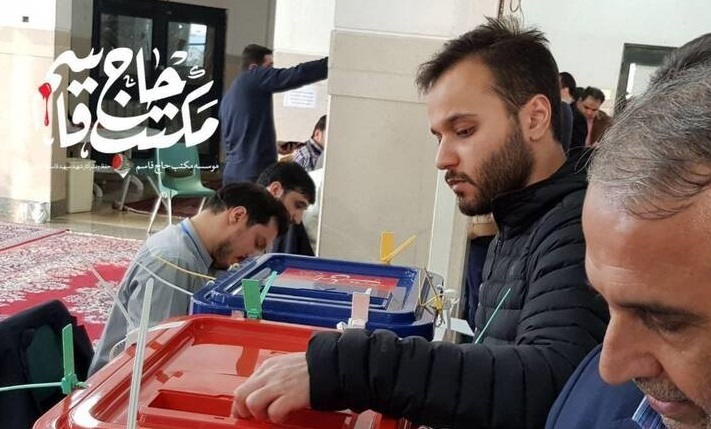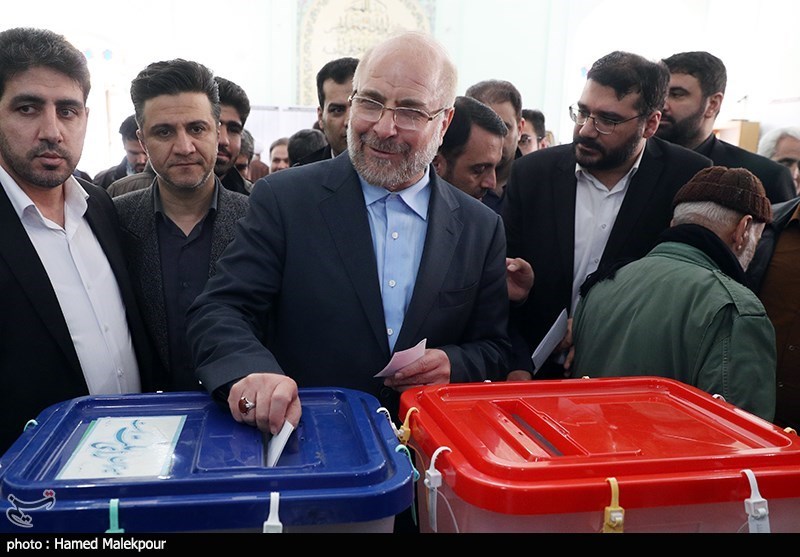February 26, 2020
Factbox: The outcome of Iran’s 2020 parliamentary elections
The Islamic Republic of Iran held its eleventh parliamentary elections on February 21. IranSource previously ran a factbox that showed why these were the most uncompetitive elections in years. Now that the elections are over, the guide below aims to illuminate its outcome and why there was a low turnout.
Who could vote?
On election day, there were 55,000 polling stations in 208 constituencies to elect a total of 290 seats in parliament. For 31 provinces, there were 174 single-member constituencies and 34 multi-member constituencies with each electing two to six members of parliament except Tehran province which elects 30 MPs. The remaining are five seats reserved for religious minorities: Jews, Zoroastrians, a shared seat for Assyrians and Chaldeans, and two for Armenians (one for Armenians in the north, one for those in the south.)
A total of 57,918,000 Iranians were eligible to vote. Of that number, 2,931,000 were eligible to vote for the first time.
Who could run?
Only candidates qualified by the Guardian Council—a vetting body of six clerics appointed by Supreme Leader Ayatollah Ali Khamenei and six jurists appointed indirectly by him—could run for parliament. More than 15,000 people applied. Of that number, 7,296 were disqualified from running; 7,148 candidates competed for 290 seats across 31 provinces. As a result, there was no serious reformist contender in the majority of the seats leaving conservatives to compete with one another.
Who voted?
Based on official results from the Interior Ministry, there was a turnout of 42.57 percent. A total of 24,512,404 took part in the elections. Of that number, 48 percent were women and 52 percent were men.
This parliamentary election had the lowest official turnout in the history of the Islamic Republic. The turnout in Tehran province was even lower at 26.2 percent—the lowest in the country. The highest reported turnout was in Kohgiluyeh and Boyer-Ahmad province with 71 percent.
This was a significant drop compared to four years ago. In the 2016 parliamentary elections, the turnout was 61.83 percent.
Why such a low voter turnout?
Mass disqualification of the reformist candidates, including about 80 sitting MPs, meant that many reformists boycotted. The reformist faction had refused to endorse any candidates in 22 out of 31 provinces, including Tehran. In addition, many voters were disillusioned with the Iranian government because of growing economic difficulties—due to US sanctions, mismanagement, and corruption—as well as the killing of demonstrators during the November 2019 protests and the downing of the Ukraine International Airlines flight.
Iran’s interior minister Abdolreza Rahmani Fazli confirmed this. He said the low turnout was “totally acceptable” and attributed it to “the Coronavirus, the political conditions and issues such as the plane crash and the events of November 2019 and January 2018.”
How did the coronavirus affect the polls?
Iran is currently dealing with the deadly spread of the coronavirus, which has a rising but unconfirmed death toll. Most neighboring countries have closed their borders with Iran in an effort to contain the virus. Health experts such as Kamiar Alaei, a clinical associate professor at the University of Oxford, have said that the elections should have been postponed to contain the spread of the virus.
In addition to the interior minister citing the virus as a reason for lower turnout, Supreme Leader Ayatollah Ali Khamenei has attacked the western media for using the virus as an excuse to discourage people from voting. Khamenei specifically pointed to the holy city of Qom as having had one of the highest turnouts in the country. Authorities have confirmed that Qom has been the epicenter of the virus. The Turkish government said the Iranian government’s refusal to put Qom under quarantine is the reason it resorted to closing its borders with Iran.
Who were some of the prominent voters?
While reformist figures such as former deputy interior minister Mostafa Tajzadeh refused to vote, some leading reformists went to the polls despite the uncompetitive nature of the elections. This included former president Mohammad Khatami and Behzad Nabavi, a former MP and cabinet minister—considered a political grandfather to many reformists. Interestingly, the picture of Khatami voting was published to encourage some to vote despite an existing media ban on using the former president’s name and images due to his support of the 2009 post-election protests known as the Green Movement.

Other voters included former president Mahmoud Ahmadinejad—even though many of his allies had not been allowed to run. Ali Motahari, a conservative but pro-Rouhani MP who was popular with many reformists, also voted though he was disqualified. According to Motahari, he was told that he had been disqualified because he openly disagreed with some positions taken by Khamenei including Motahari’s protest against the continued house arrest of 2009 presidential candidate and Green Movement leader Mir Hossein Mousavi.
Images of the son of assassinated former Quds Force Commander Qasem Soleimani taking part in the polls were published, as was that of Soleimani’s successor, Esmail Ghaani.
Who won seats in the election?
Conservatives swept 230 seats in parliament since they didn’t face any reformist competition. In Tehran, which is politically the most important constituency, the united conservative list won all 30 seats.
The lowest number of votes required to get elected from Tehran was around 600,000, whereas the highest vote for a reformist was for Alireza Mahjoob, head of Iran’s state-run trade union Workers’ House, who got 95,393. Previously, prominent reformist MPs such as Majid Ansari and Soheila Jolodarzadeh got less than 70,000 votes each.
Only Baqer Qalibaf, a politically ambitious former mayor of Tehran, received more than 1 million votes to top the list for Tehran, with the next three candidates all getting around 800,000 votes. This shows a stark contrast with 2016 when all Tehran MPs got at least a million votes.
The winning list consisted of both conservatives and ultraconservatives who had agreed on a common slate at the last minute.
Those who come on top in Tehran are usually considered to be the main political actors in the parliament. Here’s a look at the top four elected MPs in Tehran:

Baqer Qalibaf
The 58-year-old politically ambitious former national police chief has a past in the Islamic Revolutionary Guard Corps (IRGC) as chief of the air force from 1997 to 2000. During the campaign, Qalibaf repeatedly spoke of his close friendship with Soleimani during the eight-year bloody Iran-Iraq War of the 1980s. Qalibaf was the mayor of Tehran from 2005 to 2017 and some of his actions at the time were praised as effective technocratic management. Qalibaf is a repeated failed presidential candidate, having run and lost elections in 2005, 2013 and 2017. It is likely that Qalibaf will take the role of speaker of the parliament, making a base among those with economic concerns.
Mostafa Mir-Salim
Notorious as a very restrictive culture minister in the 1990s, the 72-year-old politician also ran as a candidate in the 2016 presidential elections. Mir-Salim’s rise to the top of conservative politics has been somewhat surprising. It is probably explained by the fact that he heads the central council of the Islamic Coalition Party, which dates back to 1963 and represents the pro-Islamist segment of Iran’s traditional bazaari middle class.
Morteza Agha Tehrani
The Esfahan-born 62-year-old cleric is the head of the Islamic Revolution’s Endurance Front, the main ultraconservative party in Iran. Despite his strong anti-American positions, he obtained a PhD from a New York-based university and even once held a US Green Card. Agha Tehrani first made his name as the imam of a Shia mosque in New York City before returning to Iran to run for parliament. He was a Tehran MP from 2008 to 2016 and occasionally headed the parliamentary Culture Committee but lost in the pro-Rouhani wave during the 2016 elections. The Guardian Council has previously rejected his candidacy for the Assembly of Experts, the body which nominally picks the Supreme Leader.
Elias Naderan
The French-educated conservative economist is also among those who lost their seats in 2016, after serving three consecutive terms from 2004 to 2016. In the mid-2000s, Naderan established his credibility by opposing Ahmadinejad’s outlandish economic plans as a member of the parliamentary Budget Committee.
Will there be any reformists in parliament?
So far, with most ballots counted, only 16 reformists have won seats and it’s doubtful the number will be any higher. These are mostly unknown figures with two exceptions:
Masoud Pezeshkian
The first deputy-speaker in the outgoing parliament, has also been a Tabriz MP since 2008. Pezeshkian is a medical doctor and was Khatami’s health minister in the 2000s.
Qolamreza Tajgardoon
An economist and a university professor, he was re-elected as MP of Kohgiluyeh and Boyer-Ahmad province. He was the head of the Budget Committee in the outgoing parliament.
How many women were elected?
Seventeen women were elected to parliament, while one woman is among the 14 candidates who failed to reach the required threshold and will go to the second round in May. The outgoing parliament has 17 female MPs, although in 2016, one of Tehran’s elected MPs, Minoo Khaleghi, was kicked out by the Guardian Council after the elections were over. The current parliament will keep this abysmally low female representation of around six percent, which is still an all-time record high under the Islamic Republic.

Two of the most prominent female Tehran MPs will be returning conservatives:
Fatemeh Rahbar
A 55-year-old conservative former MP from 2004 to 2016, Rahbar holds a PhD in strategic management and is best known for writing an early book about Ahmadinejad, calling him “the miracle of the third millennium.”
Zohreh Elahian
Another former Tehran MP from 2008 to 2012, who is relatively young at 51. Some see her as having the potential for higher political positions in the government.
How will the parliament change?
The new parliament has seen a complete transformation from the outgoing pro-Rouhani parliament. Less than 20 percent of the sitting MPs will continue to hold their seats. Of the 290 MPs in the current parliament, two resigned, two died and one left to become Iran’s ambassador to Russia. Of the remaining 285, many were disqualified by the Guardian Council and of the 170 who ran for re-election, only 56 won. Out of this number, 41 are conservatives. In ten out of 31 provinces—including Tehran and Alborz provinces—not a single MP was re-elected. Even among the religious minorities, only Zoroastrian MP Esfandiar Ekhtiari will return while other religious minorities will have new MPs.
The pro-Rouhani Hope Faction in the current parliament had 102 MPs of which only seven will sit in the new parliament.
Arash Azizi is a New York-based writer and academic. He previously co-hosted a program on London-based Manoto TV, which was one of the most watched news shows in Iran, and was a former international editor of Kargozaran, an Iranian daily. He is currently a doctoral student at New York University, where he researches the history of the Middle East during the Cold War. Follow him on Twitter: @arash_tehran.
Image: A woman wears a face mask during parliamentary elections at a polling station in Tehran (Reuters)